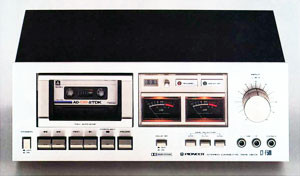The Pioneer CT-F500, a stereo cassette tape deck from the late 1970s (1978-1980), represents a significant era in audio technology. This model, part of Pioneer’s esteemed CT-F series, is recognized for its robust build and reliable performance, appealing to audiophiles and vintage audio enthusiasts alike. While not boasting the most advanced features of later models, the Pioneer Ct F500 delivers a solid foundation for high-fidelity cassette playback and recording, embodying the quality and design principles Pioneer was known for.
Key Features and Design of the Pioneer CT-F500
At the heart of the pioneer ct f500 lies a DC servo control motor. This motor is crucial for ensuring stable tape transport, a key factor in minimizing wow and flutter and maintaining consistent sound quality. Coupled with an ultra-precision engineered capstan, belt, and a large 80mm flywheel, the tape take-up mechanism of the pioneer ct f500 is designed for precision. This attention to detail in the transport mechanism contributes significantly to the deck’s overall audio performance and reliability.
 Front view of the Pioneer CT-F500 cassette deck, a classic stereo component from the late 1970s
Front view of the Pioneer CT-F500 cassette deck, a classic stereo component from the late 1970s
The pioneer ct f500 is configured as a 2-head, single compact cassette deck. It utilizes two heads: one for record/playback and another for erase functions. This setup is typical for many quality cassette decks of its time, balancing performance with manufacturing cost. It supports standard tape types including type I (normal), FeCr (ferrichrome), and CrO2 (chrome), offering flexibility in tape selection to suit different recording needs and sonic preferences. Notably, it incorporates Dolby B noise reduction, a common and effective system for reducing tape hiss and improving the signal-to-noise ratio, enhancing the listening experience particularly for quieter passages in recordings. The inclusion of VU meters on the pioneer ct f500 is also a visually appealing and functionally useful feature, allowing users to monitor audio levels during recording and playback.
Technical Specifications Overview
The specifications of the pioneer ct f500 highlight its capabilities as a solid mid-range cassette deck:
- Type: 2-head, single compact cassette deck
- Track System: 4-track, 2-channel stereo
- Tape Speed: 4.75 cm/s
- Heads: 1 x record/playback, 1 x erase
- Motor: 1 x DC servo
- Tape Type: Type I, FeCr, CrO2
- Noise Reduction: Dolby B
- Frequency Response: 30Hz to 16kHz (Cr02 tape)
- Signal to Noise Ratio: 64dB (Dolby B)
- Wow and Flutter: 0.05%
- Total Harmonic Distortion: 1.5%
- Inputs: 65mV (line), 0.3mV (mic)
- Outputs: 0.7V (line)
- Dimensions: 380 x 140 x 261mm
- Weight: 5kg
- Year: 1978
Downloads and Resources
For owners and enthusiasts of the pioneer ct f500, resources such as instruction manuals, owner’s manuals, and service manuals are invaluable. These documents provide detailed information on operation, maintenance, and troubleshooting. Schematics are also available for those undertaking more technical repairs or modifications. These resources ensure the longevity and continued enjoyment of the pioneer ct f500.
Conclusion
The Pioneer CT-F500 is a testament to Pioneer’s engineering prowess in the late 1970s. While it may not feature the cutting-edge technology of later high-end decks, its robust construction, reliable tape transport, and solid audio performance make it a desirable piece for collectors of vintage audio equipment and those who appreciate the warmth and character of analog cassette tape playback. The pioneer ct f500 remains a respected and fondly remembered model in the history of cassette decks.


